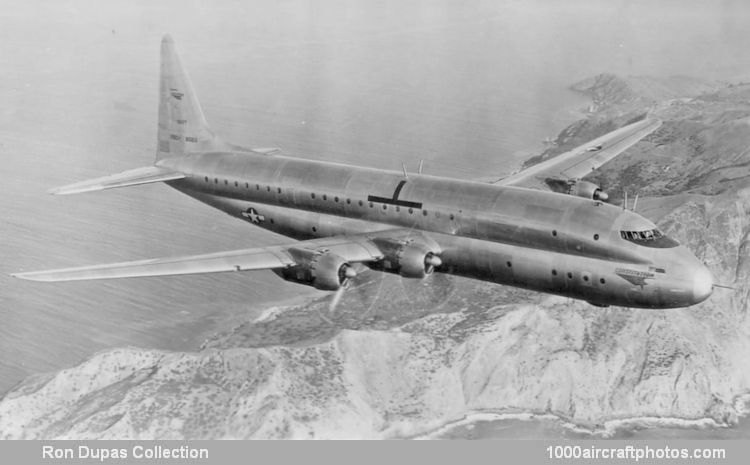Due to other and higher priorities the first Constitution (BuNo. 85163, c/n 089-1001) flew not until November 9, 1946. It was powered by four 3,000 hp Pratt & Whitney R-4360-18 28-cylinder radial engines, but these were soon replaced by the 3,500 hp R-4360-22W with water injection. The second aircraft (BuNo. 85164, c/n 089-1002) flew with the R-4360-22W engines, for the first time in June 1948.
At the moment of its first flight the Constitution was the largest transport aircraft ever flown and had apart from its size some other novelties. The fuselage cross-section was a "double-bubble" which allowed for two approximately equally-sized pressurized cabins, these being interconnected by spiral staircases. In the normal airline configuration there was place for 168 passengers, in maximum density configuration 204 military personnel could be seated, and there was a galley for preparing food for over 200 people.
In the mixed version passengers were carried on the upper deck with cargo on the lower deck loaded through cargo doors fore and aft of the wing. Other novelties were: large depth of the wings allowing access to the engines during flight; hydraulic and electric control centers with fully equipped workshop located in center section of wing; main landing gears consisted of two two-wheeled struts on each side of the fuselage, the wheels were pre-rotated to landing speed just prior to landing.
Already before the first flight Pan American decided not to buy the Constitution, but the first aircraft entered service with the USN's Transport Squadron Forty Four (VR-44) at NAS Alameda, California, USA., on 2 February 1949; the second aircraft was assigned to the squadron in August 1949. Still underpowered the fully loaded the range was 2,400 mls (3,862 km) instead of the expected 6,300 mls (10,139 km). The cooling of the engines was a major problem, to solve this the cowl flaps were kept partially open during flight, this increased the drag of the already underpowered. In 1950 the Manufacturers Code for Lockheed changed from "O" to "V" and the Constitution was redesignated XR6V-1.
In 1953 the USN retired the two aircraft storing them at Litchfield Park, Arizona, being sold in 1955 to separate buyers; one flew to Las Vegas, Nevada and the other to Opa-Locka, Florida. However, both aircraft never got their civil type certification. The pictured aircraft received the civil registration N7673C but a fire destroyed its interior. The last owner of this aircraft was Frank Sosa Sr., who intended to convert it into a restaurant, but this plan did not materialize. The aircraft was eventually scrapped."
Span: 189 ft 1.25 in (57.64 m)
Length: 156 ft 1 in (47.57 m)
Height: 50 ft 4.5 in (15.35 m)
Wing area: 3,610 sq.ft (335 sq.m)
Empty weight: 114,575 lb (51,971 kg)
Max T/O weight: 184,000 lb (83,462 kg)
Max speed: 303 mph (488 km/h) at 20,000 ft (6,096 m)
Climb: 1,010 ft (308 m)/min
Service ceiling: 28,000 ft (8,534 m)
Range, empty: 6,300 mls (10,137 km)
Range, fully loaded: 2,400 mls (3,862 km)
